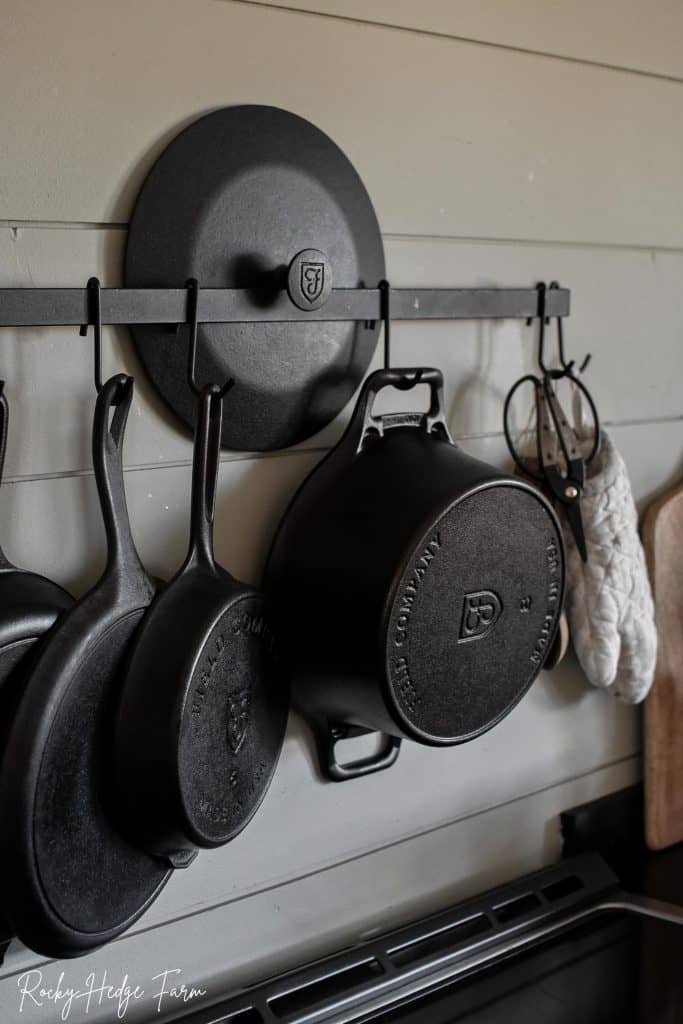How to Clean Cast Iron Skillet After Use
Cleaning your cast iron cookware is an essential part of caring for it. But how often should you do it? And what’s the best way to clean it? Cleaning your cast iron cookware doesn’t have to be complicated – follow a few simple steps to learn how to clean cast iron skillets after use.

Cast iron skillets are one of the most versatile and durable cookware options.
They are an excellent investment for your kitchen because they can be used for cooking everything from frying eggs and bacon to making delicious sausage gravy and a scrumptious Sunday pot roast dinner.
Cleaning Cast Iron Cookware
Cast iron skillets offer many benefits that make them worth investing in. They are durable, non-stick, and have a natural non-stick coating when seasoned correctly.
They also provide superior heat retention and distribution, perfect for cooking at high temperatures or searing meat on the stovetop.
Cast iron skillets are an excellent cooking tool. They are durable and can last for a lifetime. However, the pan can become dirty and difficult to clean when food is cooked after use and not cleaned properly.
Here are some valuable resources to keep in mind when cooking with cast iron cookware:

Do You Clean a Cast-Iron Skillet After Each Use?
Cast iron skillets should be cleaned after each use. Proper cleaning is the best way to care for your cast iron skillet. This post will show you the steps to take to ensure that your skillet lasts for many years.
Kitchen Essentials You may Need
- Dish Soap: I like using a gentle, non-abrasive dish soap. I like using a solid dish soap made with few ingredients.
- Cast Iron Scrub Brush: a cast iron scrub brush has a built-in pan scraper to remove the toughest baked-on bits of food residue without removing the pan’s seasoning.
- Salt: sprinkle kosher salt into the skillet to help remove stuck-on food bits.
- Nylon Pan Scrubber: This pan scraper tool is excellent for cleaning and scraping the build-up of food that can occur on an iron skillet.
- Oil: You want one high in polyunsaturated fats, such as organic, cold-pressed grapeseed oil and organic linoleic sunflower oil.
- Paper Towels or Dry Clean Cloths: Used to dry a cast iron skillet after washing it and rubbing the oil into it.
How Do You Clean Cast Iron After Cooking?
A cast iron skillet is a must-have for any kitchen. It can go from stovetop to oven, and the food cooks evenly and tastes great. But, it needs to be adequately cleaned. Here are five easy steps to clean your cast iron skillet after using the right way:
Step 1: Allow the Skillet to Cool
Once you have finished cooking in the cast iron skillet, remove it from the burner and allow it to cool. Then, using a wooden spatula, remove any excess food.

Step 2: Clean the Skillet
There are several ways to clean cast iron skillets, but the most common is to wash them by hand with warm water and a small amount of gentle dish soap.
To clean the skillet, avoid harsh chemicals and steel wool. Instead, use a soft scrubber or dish towel to remove oils and dirt with hot water. This will keep the seasoning intact. Once clean, rinse the pan with warm water.
Sometimes, the pan’s seasoning wears off, which means that food might stick to it. To get rid of food residue, wait until your pan has cooled, and then scrub it with coarse salt using a nylon pan scrubber or chainmail scrubber.
Step 3: Dry the Skillet
After rinsing, dry the cast iron skillet entirely with a dishtowel. Then put it on the top of the stove and turn the heat to low for a few minutes to ensure all the moisture evaporates.

Step 4: Oil the Skillet
Add a light layer of oil (about 1/4 teaspoon) to the skillet and set it on low to medium heat. Rub the oil into the skillet’s surface using a dry paper towel or other dry cloth.
Heat the skillet until the oil starts to smoke, then turn off the heat and let the pan cool to room temperature. Once the skillet is cool, wipe off any excess fat with another dry cloth or clean paper towel.
This process is called seasoning the skillet. It creates a nonstick surface on your skillet that also helps prevent it from rusting.

Step 5: Store the Cast Iron Skillet
To avoid rusting, keep your cookware in a dry place with the lids off. Leaving cast-iron cookware in a damp or humid environment can cause rust to form on the surface and eventually ruin your pan.
Follow this post for tips and ideas on storing your cast iron pan properly so it is ready when you need it.

The Don’ts of Cast Iron Skillet Cleaning
- Avoid the Dishwasher: Cleaning cast iron pans in the dishwasher will cause them to rust and deteriorate faster than if they were cleaned by hand. Dishwasher detergents are harsh on the metal, causing it to lose its protective coating and vulnerable to rusting.
- Don’t Let the Pan Soak: When you soak your cast iron in water, rust will form, and your cookware’s non-stick surface will erode. Dry your cast iron thoroughly after each use, and avoid soaking it.
- Avoid Thermal Shock: If you just cooked something in a cast iron pan, don’t take it off the stove and put it in cold water to cool it down. The temperature difference could cause thermal shock, warping, or cracking of your skillet or pan.
Should I Oil My Cast Iron After Every Use?
To get the most out of your cast-iron skillet, it is best practice to apply a thin layer of oil to the surface after each use. Regularly oiling your cast-iron skillet will provide a protective layer and help keep it from rusting.
What is the Best Oil to Season Cast Iron
The best oil for seasoning cast iron and other cast-iron cookware is high in polyunsaturated fats. Oils such as organic cold-pressed grapeseed oil and organic linoleic sunflower oil are the best oils for this purpose.
Another excellent option for seasoning oil is to purchase a high-quality pre-made blend. My personal favorite is the Seasoning Oil from Field Company. It mixes beeswax, organic grapeseed oil, and organic sunflower oil.

How To Maintain Your Cast-Iron Skillet After Use?
Cast iron is one of the most durable materials, but it must be cared for to maintain quality. The key is to prevent any rust from forming and keep the surface as nonstick as possible.
If you stick to a routine of cleaning your cast iron skillet after use, you will achieve a natural non-stick surface by cleaning and oiling it.
My Favorite Cast Iron Cookware and Supplies
A cast-iron skillet is a must-have for any kitchen. They are durable, functional, and also have aesthetic value. The features that you should consider are the weight, size, and shape of the pan, as well as its handle design.
- Field Company: I have owned quite a few cast iron pans and dutch ovens, but these are the best! They are the lightest cast iron pans I have ever used and come pre-seasoned, which is fantastic. These pans are incredibly smooth to cook with and hold heat well.
- Seasoning Oil: I used to buy individual bottles of oil. However, after discovering this seasoning oil, I use it to protect my cast iron and build a naturally non-stick seasoning.


About Sarah
Wife. Mother. From-Scratch Cook. Homemaker.
I’m Sarah, the creator of Rocky Hedge Farm, where I share my love for simple living, homemade meals, and creating a cozy home. As a wife and mother, I’m passionate about slowing down, cooking from scratch, and finding joy in the everyday moments of life. From DIY projects and family-friendly recipes, I hope to inspire others to embrace a life rooted in simplicity and warmth.





